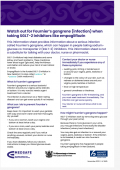Jardiamet
Also called empagliflozin + metformin
Key points about Jardiamet
- Jardiamet is used to treat type 2 diabetes.
- It's a combination of 2 medicines, empagliflozin and metformin, in a single tablet.
- Find out how to take it safely and possible side effects.

Type 2 diabetes
Jardiamet is mainly used to treat type 2 diabetes and protect your kidneys and heart. It's a combination of 2 medicines, empagliflozin and metformin, in a single tablet.
- Empagliflozin lowers your blood glucose by helping your kidneys get rid of glucose when you pass urine (pee/mimi).
- Metformin lowers your blood glucose by reducing how much glucose is released from the liver, where it is stored and helping the cells of your body to absorb more glucose from your bloodstream.
Jardiamet has other benefits. It can help with weight loss, protects your kidneys and heart, reduces your risk of having a heart attack and lowers blood pressure. It may also help you live longer. Jardiamet is best used together with healthy eating and regular exercise. Read more about type 2 diabetes.
Type 2 diabetes and heart failure
You may also be prescribed Jardiamet if you have diabetes and heart failure. When used along with other medicines for heart failure, empagliflozin reduces breathlessness, tiredness, and ankle swelling. It helps to remove excess fluid and salt when you pee. It lowers your chances of hospital admission for heart failure.
Funding in New Zealand
In Aotearoa New Zealand Jardiamet is funded for some people with type 2 diabetes or type 2 diabetes and heart failure, who meet the Special Authority criteria. A special authority means your doctor or specialist will need to make an application to Pharmac (the government medicine funding agency) for approval before the medicine can be funded for you.
Note: Empagliflozin on its own is called Jardiance. Read more about empagliflozin.
Video: How to take empagliflozin (Jardiance and Jardiamet) in English
Video: How to take empagliflozin (Jardiance and Jardiamet) in te reo Māori
(Healthify He Puna Waiora, NZ and PHARMAC, 2022)
In Aotearoa New Zealand Jardiamet tablets are available in 4 strengths depending on the amount of empagliflozin and metformin in each tablet:
- Jardiamet 5 mg/500 mg
- Jardiamet 5 mg/1,000 mg
- Jardiamet 12.5 mg/500 mg
- Jardiamet 12.5 mg/1,000 mg

Check with your healthcare provider which strength you are taking.
- The usual dose of Jardiamet is 1 tablet twice a day.
- Your doctor may start you on a lower strength tablets and depending on your blood glucose levels, your healthcare provider may increase the strength.
- Always take Jardiamet exactly as your doctor has told you. The pharmacy label on your medicine will tell you how much to take, how often to take it and any special instructions.
- Timing: Take Jardiamet 2 times a day, in the morning and the evening. Jardiamet is best taken with or just after food or a meal, to lessen the chance of stomach upset.
- Drink enough water so you don't get thirsty: When you start taking Jardiamet, you may pee more but this gets better over a few weeks. If you’ve been told to limit how much you drink, talk to your healthcare team.
- Avoid or limit alcohol while you are taking Jardiamet: Alcohol may affect your blood glucose control and increase your risk of side effects. Drinking alcohol very often or drinking a lot of alcohol over a short time (binge drinking) can affect your diabetes and lead to high ketone levels. This can cause a serious but rare side effect called ketoacidosis.
- Missed dose: If you forget to take your dose, take it as soon as you remember that day. But if it's nearly time for your next dose, just take the next dose at the usual time. Don't take double the dose.
- Don't run out of tablets: Jardiamet works best when taken every day. See your healthcare team every 3 months for a new prescription.
Here are some things to know when you're taking Jardiamet. Other things may be important as well, so ask your healthcare provider what you should know about.
You are at increased risk of urinary tract or fungal genital infection (thrush)
Jardiamet causes you to pee more and have more glucose in your urine, which increases your risk of getting a urinary tract infection (UTI) or thrush around your vagina or penis. Germs (bacteria and fungus) like to grow in body fluids with a high sugar content. As your blood glucose level decreases, this tends to settle.
To reduce the risk of infection, wash your genital area (privates) with warm water using non-perfumed soap. Also, any drops of pee left behind on the penis or vagina need to be removed each time you pee.
- If you have a vagina, wash your vulval area twice a day. After you pee, rinse the area with water and then pat dry with toilet paper. If you can't rinse, just pat the area dry carefully with toilet paper.
- If you have a penis, wash your groin area at least once a day. Pull back your foreskin before you pee, to avoid drops of urine spilling into the foreskin fold. After you pee, rinse your penis with water and then pat dry with toilet paper. If you can't rinse, just pat the area dry carefully with toilet paper.
If you get any of the following symptoms, contact your healthcare provider immediately
It's important to treat thrush or UTI early. If left untreated, it can turn into a serious life-threatening infection called Fournier’s gangrene(external link). |
Have a sick day plan
If you're unwell with vomiting, diarrhoea or a fever or you're not eating or drinking as usual, stop taking Jardiamet. Only restart Jardiamet when you are well AND have been eating and drinking normally for 1 or 2 days.
- Taking Jardiamet when you are unwell increases your risk of high ketones levels, which can cause a serious but rare side effect called ketoacidosis.
- Ketoacidosis causes your blood to become too acidic and can be very dangerous if it's not treated.
|
If you have nausea (feeling sick), vomiting (being sick/puking), pain in your tummy (puku), and feel very unwell and confused:
Ketoacidosis is very serious and needs immediate treatment. |
Being dehydrated and not eating enough carbohydrates can cause serious side effects
Being dehydrated and not eating enough carbohydrates can lead to high ketone levels, which can cause a serious but rare side effect called ketoacidosis.
- Tell your healthcare team before making any big changes to your diet: It's a good idea to cut down on foods with added sugar if you have diabetes. However, having too few carbohydrates in your diet while you're taking Jardiamet may increase your risk of ketoacidosis. Tell your healthcare team if you start eating less, go on a keto (low carbohydrate) diet or if you're fasting. Read more about empagliflozin, fasting and low carbohydrate diets(external link).
- Fasting during Ramadan: If you're fasting during Ramadan and are still getting enough carbohydrates, you can keep taking Jardiamet. It's important to talk to your healthcare provider about getting enough carbohydrates and drinking plenty of water while taking Jardiamet. It's not recommended to start Jardiamet as a new medicine immediately before or during Ramadan.
- Long-distance runners or cyclists: If you're going to run or cycle a long distance while you're taking Jardiamet, it's important to let your healthcare provider know. You may need to stop Jardiamet the day before the event and restart 24 hours or so afterwards when you are well hydrated and eating normally.
Preparing for an operation or a procedure
If you're going to have an operation or a procedure where you will need to stop eating for 12 hours or more (eg, a colonoscopy or dental surgery), ask your healthcare team when you should stop and restart your Jardiamet. You may need to stop your Jardiamet 3 days before the operation or procedure.
Are you pregnant, trying for a baby or breastfeeding?
It's important to talk to your healthcare provider as soon as possible if you're trying to get pregnant, are pregnant or breastfeeding. You may need to change to another diabetes medicine.
Tell your healthcare team if you are taking any other medicines
Jardiamet may interact some medicines and herbal supplements, so check with your doctor or pharmacist before starting Jardiamet and before starting any new medicines or herbal supplements.
Like all medicines Jardiamet can cause side effects, although not everyone gets them. If you're concerned about any symptoms you think might be related to your medicine, talk to your healthcare provider. The following information offers some guidance but doesn't include all possible side effects.
Common side effects
Tell your healthcare provider if these bother you.
- Peeing (urinating) more often than usual.
- Mild skin rash or itchy skin.
- Feeling dizzy. Don't drive or use machinery if you're feeling dizzy. Also, don’t drink alcohol if you are feeling dizzy, as this can increase your risk of falls.
Tell your healthcare provider immediately or phone Healthline free on 0800 611 116 if these occur
- Signs of thrush or urinary tract infection (UTI) such as irritation or itching, pain, swelling or redness in your genital area, or pain or burning feeling when you pee.
- Signs of diabetic ketoacidosis (DKA) such as being sick (vomiting), feeling very thirsty (dehydrated), being confused or unusually tired or sleepy, tummy (abdominal) pain, sweet-smelling breath, deep or fast breathing. You're at increased risk if you are dehydrated or have a sudden illness, drink large amounts of alcohol, have just had surgery, have reduced your calorie intake, are on a low carbohydrate diet or if your insulin requirements have increased.
- Signs of Fournier’s gangrene such as swelling, pain, itching or tenderness in or around your vagina, penis, testicles or bottom, changes to the colour of your skin, such as redness or darkened areas around your vagina, penis, testicles or bottom, fever or high temperature, general feeling of being unwell, or tiredness. Read more about Fournier’s gangrene.(external link)
Read more about medicines and side effects and reporting a reaction that you think might be a side effect.
Brochures
Jardiamet(external link) Medsafe Consumer Information, NZ
Jardiamet factsheet [PDF, 272 KB] Healthify He Puna Waiora, NZ
Empagliflozin, fasting and low carbohydrate diets(external link) Western Bay of Plenty Primary Health Organization, July 2023
At home sick day advice(external link) Health New Zealand | Te Whatu Ora
Risk of Fournier’s gangrene infection when taking empagliflozin(external link) Medsafe, NZ, 2022 English(external link), te reo Māori(external link), Samoan(external link)
References
- Empagliflozin + metformin hydrochloride(external link) NZ Formulary
- Giola M. Sweet urine, bitter outcome – Empagliflozin and balanoposthitis(external link) New Zealand Doctor, February 2024
- Reminder – flozins and the risks of diabetic ketoacidosis and Fournier’s gangrene(external link) Medsafe, NZ, 2022
- Spotlight on empagliflozin(external link) Medsafe, NZ, December 2020
- Periprocedural diabetic ketoacidosis (DKA) with SGLT2 inhibitor use(external link) NZSSD, 2020
- SGLT2 inhibitors(external link) Type 2 Diabetes Management, NZSSD, 2021
- Position statement on ketogenic or very-low-carbohydrate diets and the use(external link)
of SGLT2-inhibitors in adults with type 2 diabetes(external link) NZSSD, 2021 - Empagliflozin and dulaglutide – your questions answered(external link) He Ako Hiringa, NZ
- Diabetes management during Ramadan(external link) Research Review, NZ, 2023
-
Reminder – risk factors for ketoacidosis with SGLT-2 inhibitors(external link) Medsafe, NZ, December 2024
Brochures

Healthify He Puna Waiora, NZ, 2021

Risk of Fournier’s gangrene infection when taking empagliflozin
Medsafe, November 2022
English, te reo Māori, Samoan

At home sick day advice
Health New Zealand | Te Whatu Ora, 2023
Credits: Sandra Ponen, Pharmacist, Healthify He Puna Waiora. Healthify is brought to you by Health Navigator Charitable Trust.
Reviewed by: Angela Lambie, Pharmacist, Auckland
Last reviewed:
Page last updated:





